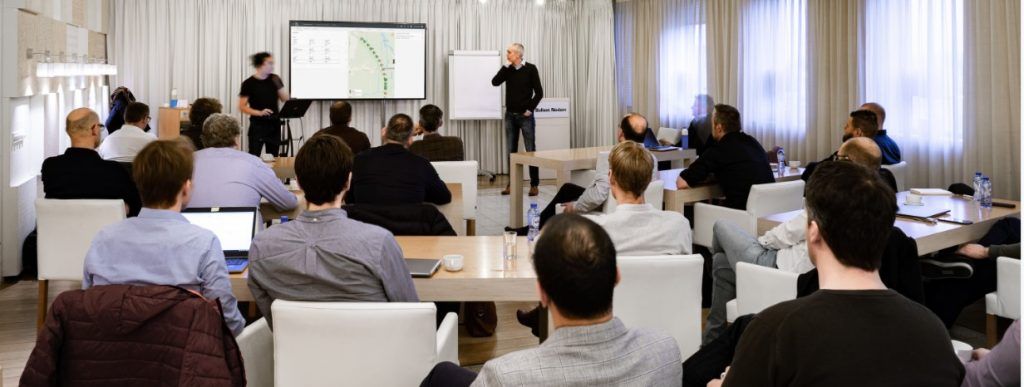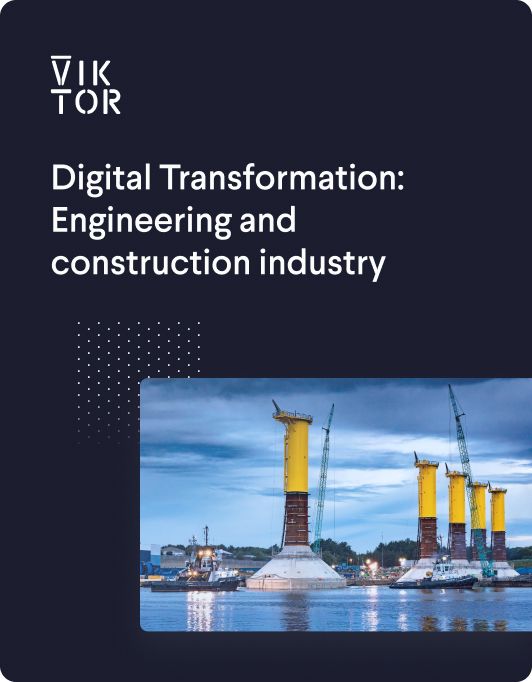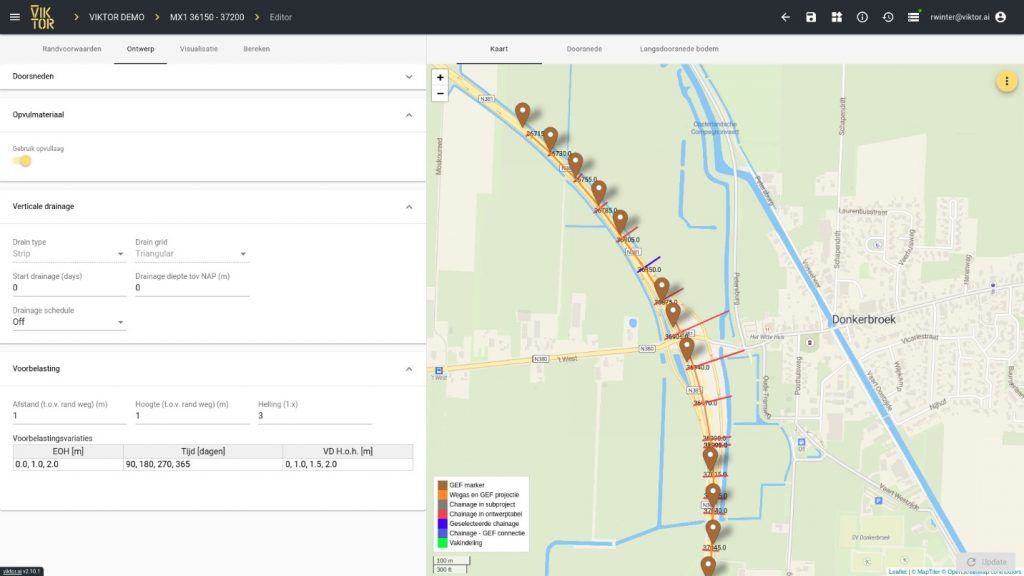The Digital Engineering Community is Accelerating


Download the White Paper and get INSPIRED
Learn about trends in digital transformation and how they affect the engineering and construction industry.
The Digital Engineering Community is exanding
After successful initial developments, the community is now expanding with Boskalis, Dura Vermeer, Mobilis, Van Oord and Volker Wessels. “In the past period, we have learned how to work together more effectively without losing our distinctiveness: increasingly focusing on digital building blocks. In these building blocks, standard actions are automated based on which each participant can build their own strategic application. We are therefore calling on more market parties to participate!”.
The starting point
Heijmans is one of the first companies to use the VIKTOR Platform on a larger scale. Great digital successes have been achieved on a number of projects such as Wintrack, Wilhelmina Canal and Dike Reinforcement Project Gorinchem – Waardenburg. Combining the technical challenges of these projects with automation of the design and construction process proved very valuable, allowing knowledge and know-how to be scalable, and increasing the number of generated solutions. For example, for the Wilhelmina Canal project, all kinds of damage scenarios could easily be calculated, making it possible to discuss all options with the client. With the Wintrack II project, it was possible to design the most optimal foundation based on construction-related criteria at the touch of a button, and with the Dike Reinforcement Gorinchem – Waardenburg project, the design stability calculations can be finished in a fraction of the time compared to before.
First collaboration
You would expect a construction company to keep these kinds of innovations under wraps to distinguish themselves from their competitors. “This was also the first thought”, laughs Marcel. “That is still very much in our genes.” Nevertheless, Heijmans chose to seek collaboration. This has to do with the fact that Heijmans made two important observations during its own developments. “On the one hand, we saw that fellow construction companies were doing more or less the same thing. And just as importantly, if everyone does this side by side, it is unnecessarily expensive and slow.” These reasons prompted Heijmans to approach several infrastructures companies through the VIB to develop a joint application. “This was in 2018 with a number of sessions on two exciting topics: digitization and collaboration. Halfway through 2019, we agreed with Ballast Nedam, BAM and Heijmans that we had to try this.”
First development: soil layout application
This led to the start of the development of an application for soil layouts. To start development, a Product Owner (senior geotechnical advisers) was appointed from each of the companies to jointly consider what functionality was needed to make the application successful. It turned out that the wishes of the companies were not that different, so that selection for “must haves” and “nice to haves” were quickly made. An interesting moment in the development of the application was when the user of the application changed from the geotechnical consultant to another end user, the cost expert and the planner. The application makes it possible for both of them to look for the best design solution for the project, without the direct intervention of the geotechnical consultant (who simply approved the model in advance).
 Soil layout modeling application
Soil layout modeling application
The application is a success, which was not certain in advance since a joint development like this had not been done before. Collaboration between the companies was also very positive and the feeling arose that collaboration might be essential. From this, the DEC idea was born.
Founding of DEC
Joint development
In February 2020, the resulting application was presented to the companies first involved in the discussions in 2018. Since then, most companies had experimented internally with coding and application development, and they have undoubtedly concluded that professional development costs more time and money than initially thought. The time was right to investigate whether joint development is possible, and the DEC was established. After a number of meetings, the most important follow-up steps were taken, in which the parties defined the following developments that will be tackled jointly. A GWW application is being developed that makes a universal link to and from Civil3D, MxRoad and AHN. As a second development, an application will be made for the design of pile foundations, linking Scia Engineer and D-foundation.
Fascilitating role
Eight construction companies participate in both developments. VIKTOR itself is not a participant, but facilitates on the basis of experience and expertise. The fact that the applications are developed on the VIKTOR Platform was a logical choice. “The platform has been specially developed for technical companies, it has a rich amount of digital building blocks for our rapidly growing sector and facilitates collaboration and application distribution,” explains Marcel. “It also has a more practical reason. All participants use the platform separately. As a result, we develop in the same way, making collaboration possible and efficient. The output is also readable (Python) code with which companies can continue to develop independently of the platform. In addition, we make use of their knowledge and experience. That is VIKTOR’s core business and by engaging them we put some of the responsibility outside the door. Our own developers learn from this collaboration, but at the same time there is a high degree of certainty that developments will be delivered within time and budget. The Product Owners of the companies remain responsible for the functionality of the application. The development of the dyke application has shown that this separation of responsibilities works well and strengthens cooperation.”
Cooperative construction companies
Until now, the collaboration has been very easy, and requires almost no effort. Construction companies are used to working together on projects and this new theme shows that we can easily find each other in different subjects and builds mutual trust. Of course, matters such as IP are contractually recorded, but this is in broad lines only, and not in every in detail, therefore trust is central. We assume that everyone participates with a positive attitude and has a name to lose. Everyone is also free to choose to participate or not in a development, possibly by joining later. Different ways to participate are by supplying usable existing code, by making an experienced programmer available or simply in euros. In the future, expansion with other companies is the obvious next step.
The future of the community
To give the community more visibility and recognition, the digitalengineeringcommunity.nl website was established. “The purpose of the website is mainly to show who is participating and what we are all developing. Hopefully it will be more widely recognised in the market that, being on your own is alone and that the future lies in developing together. We therefore urge all parties in the sector to contact us!”
About DEC
The Digital Engineering Community (DEC) is being set up (formal start at the end of February) and consists of a non-exclusive collaboration between the companies Ballast Nedam, BAM, Boskalis, Dura Vermeer, Heijmans, Mobilis, Volker Wessels and Van Oord. The affiliated companies can submit topics for development and discuss periodically who wants to participate in which development. There is no obligation to join all developments and it is possible to join later in the process. Within the DEC, digital building blocks are being developed in a modular way. These digital building blocks can be anything from general functions such as calculating headpile reinforcement to an integral link with Civil3D. Companies are then free to jointly develop these further together into integrated solutions such as the soil layout or to integrate them within an internal process of the company itself.
About VIKTOR
VIKTOR is a web-based development platform for building online applications for technical processes. By means of an SDK and the programming language Python, employees of companies can automate processes more easily, integrate with other software and distribute to colleagues, either on their own or together with the developers at VIKTOR. A large number of standard building blocks are already included in the VIKTOR Platform, both general and industry specific. For example, for the civil engineering sector, there are useful ways to process soil information, mapping functionalities and integrations with the most commonly used software packages.
The VIKTOR Platform makes version and user management of the use of applications easy. Because data is stored centrally, a “Single Source of Truth” becomes standard for all users. Changes in assumptions or requirements are therefore immediately visible in all disciplines, making interfaces more manageable and controllable. This speeds up and improves technical processes such as the design process.
Source: Magazine Land+Water nr 1/2 – February 2021


